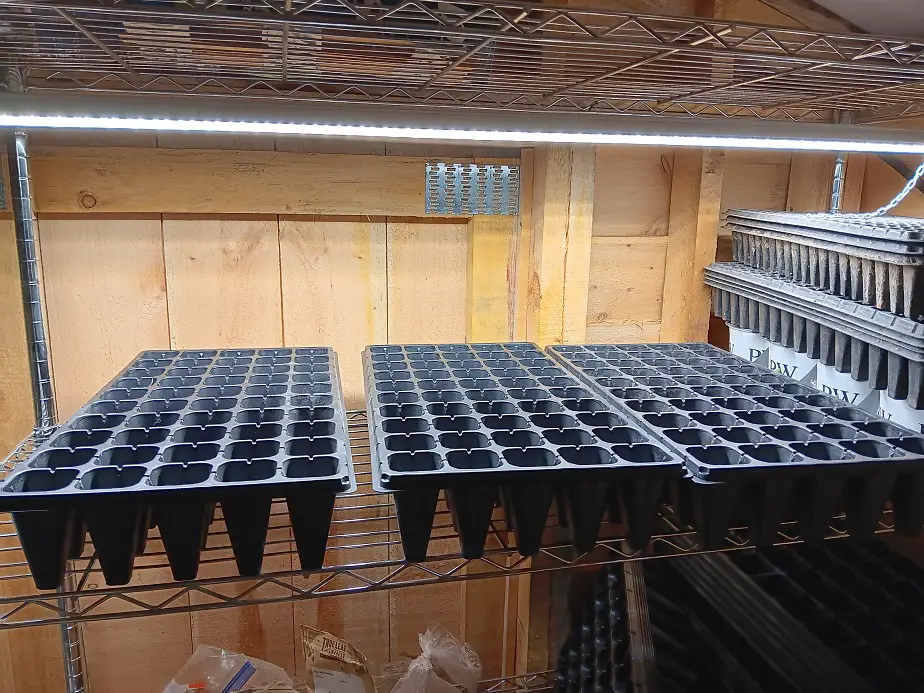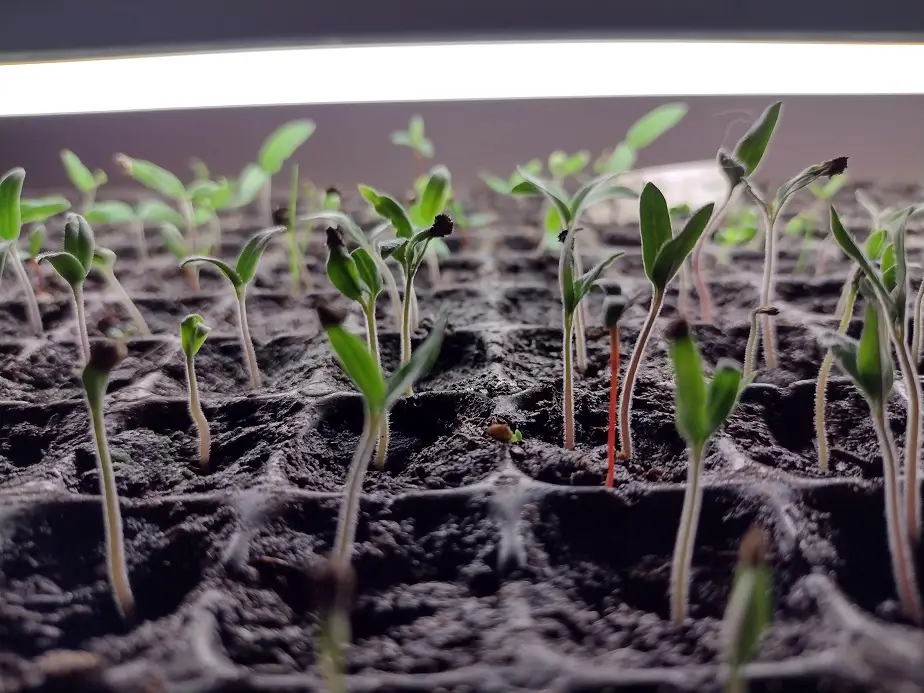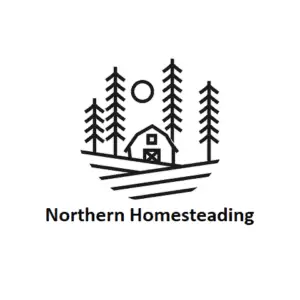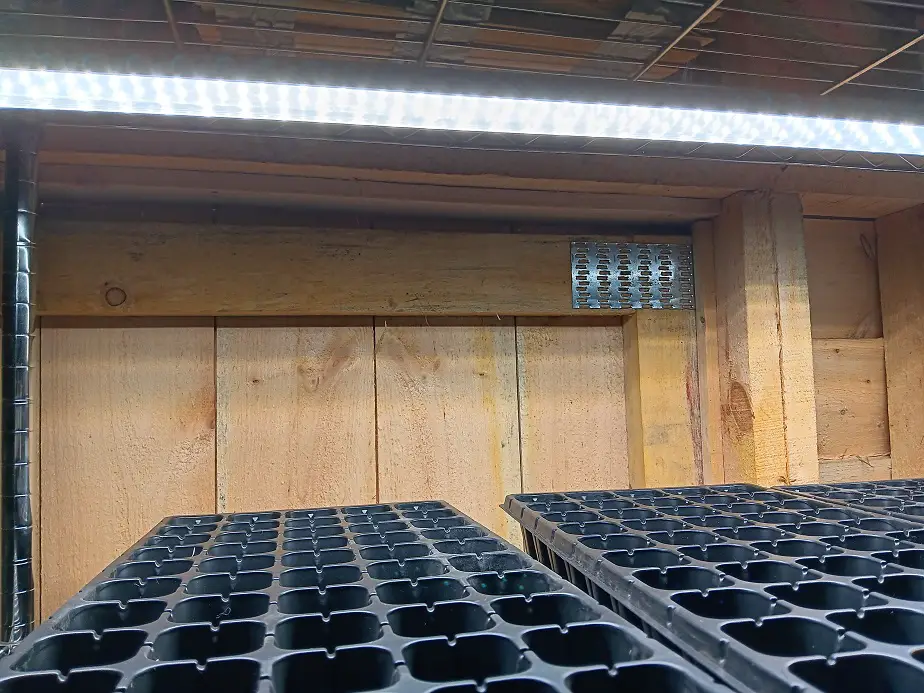I start thousands of plants every year indoors. We’ve tried a lot of grow light options, and here’s what I’ve found out.
The Best Grow light for home growers is the SZHULX SZ-6T60WD Shop/plant light. They are brighter and cheaper than other options, and quite compact. The 60-watt LED fixture is 48 inches long and will light between two and four 10×20 plant trays. Is has a cool operating temperature, intense light, and a good light color for seedlings in particular.
I have a few other recommendations based on my genuine experience.
The Most Common Grow Lights for Seedlings Used by Professionals
The most common grow light used by professional growers is a basic fluorescent shop light. The ballast-style T-8 shop light fixtures with two basic bulbs are the most common. A mid-spectrum build between 5,000 and 6,000 kelvin is quite common. These are cheap, reliable, and efficient. Most fixtures like these produce around 5,000 lumens between both bulbs.

- Here’s a link to it on Amazon- SZHULX SZ-6T60WD light system
- They have two models. Make sure you select the ‘SZ-6T60WD’
My first light was an incandescent bulb from the hardware store. It said “Plant Light” and guaranteed to make plants look greener and healthier”. It was not a grow light. It was a simple 100-watt, cool-white lightbulb. It didn’t work very well. It likely put out around 1,500 lumens of mid-spectrum light. That can be enough for one or two plants if it’s very close.
I was trying to use it for two 10×20 seed-starting trays. I would have needed at least three of them evenly spaced and very near to my seedlings to work much at all. The issue with regular-type lightbulbs is that they are not spread out enough for even, close coverage. That’s why I went with fluorescent tubes after my first failed year.
Basic fluorescent shop lights work well as long as they are within a few inches of your plants. I like tio keep them between 1 and 3 inches from the top of my seedlings and older plants. They don’t get hot enough to burn plants, except for very tender seedlings. Just don’t let brand-new seedlings tough the bulb.
I tried the GE grow light LED tubes, and they were a bit better than the fluorescent tubes. It just replaces the older style bulb and works in the same fixture. My seedlings noticeably improved with that light. But, they were expensive, and still considered lower-end for a plant light.
I ordered several different options from Amazon, but none worked well at all until recently. I finally found a light option that was both good and cheap. I ordered the SZHULX SZ-6T60WD LED strip light from Amazon and absolutely love it. It’s as bright as the best options on the market and without the ridiculous prices.
Arguably the best grow light available is the
- SunBlaster LED strip light sold by Johnny’s.
It’s about 5100 lumens and costs something around $150 for a 48-inch strip. They are very well made and sturdy, but they are also overkill for what most home gardeners will ever need. I don’t generally recommend it.
For just under $100, I bought a six-pack of the SZHULX lights. They are lighter-duty, but they seem like they will last me years of using for a month or two every spring. They are the brightest LED plant light I’ve found. I love them. One will light up enough for a 24×48-inch shelf of plants. They also have a wide beam angle so they still spread the light well when set close to the plants.
They have one downside shared by al strip-type LEDs. They’re skinny. That means the plants on the end will be s few inches further from the light source. That can make a difference, But, since the SZHULTX lights are so bright, it makes up for that.
These really are some of the most common grow lights used by professional growers.
- SZHULTX SZ-6T60WD LED strip light
- SunBlaster 48′ LED strip light
- Common T-8 fluorescent Shop light (dual bulb)

How To Troubleshoot Lighting Problems With Seedlings
The most common problem with seed-starting lights is that the seedlings are not getting strong enough light. This is clearly shown by pale, leggy, and spindly seedlings. You can fix the issue by moving lighting closer, and/or adding stronger lighting.
Plants need a minimum of about 1,000 lumens per square foot of growing floor. That’s 1/10 of the intensity of the sun, and it requires some very good lighting. The intensity also dramatically reduces with distance. For example, at one inch from the bulb, you may have 8,700 lumens, but at 6 inches from the bulb, you have barely 1,000 lumens per square foot with a common-type grow light.
By far, most grow lights are not giving enough light for the distance and number of plants at play. I like to err on the side of more lighting. It can cost another dollar a day to have a second high-output LED going, but the extra light makes a world of difference for anyone growing enough plants to fill a garden.
I try and keep 1,000 lumens a square foot over my seedlings. I know many growers who prefer a minimum of twice that. You need to realize that 1,000 lumens is the strength of the sun on a cloudy day. It’s not great, but it can work. I have never heard of someone going as far as 10,000 lumens (the strength of sunlight on a clear day). The only person I know who has tried to get close was a cannabis grower with a crop worth hundreds per plant.
I much prefer a tube or strip-type light over a round bulb because the lighting is so easy to evenly cover an entire tray of seedlings. Plants also need the right color of light. For seedings, it’s easy. They like a whiter color light as is common in normal lighting. To promote fruiting and flowering of mature plants, a more red spectrum light is generally optimum.
If you were to go into an indoor nursery without natural sunlight, You’d probably see either pinkish or slightly purple-colored light. But for seedlings and general green growth, a more natural sunlight sort of light color is best.
Related Articles:

